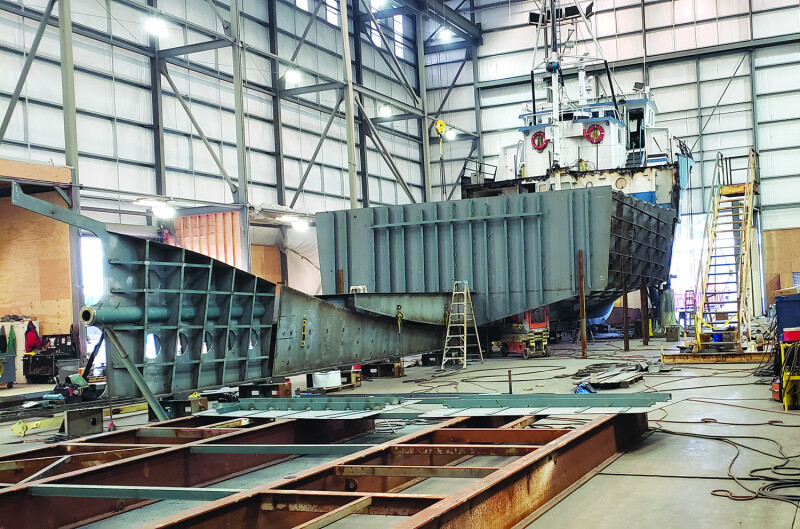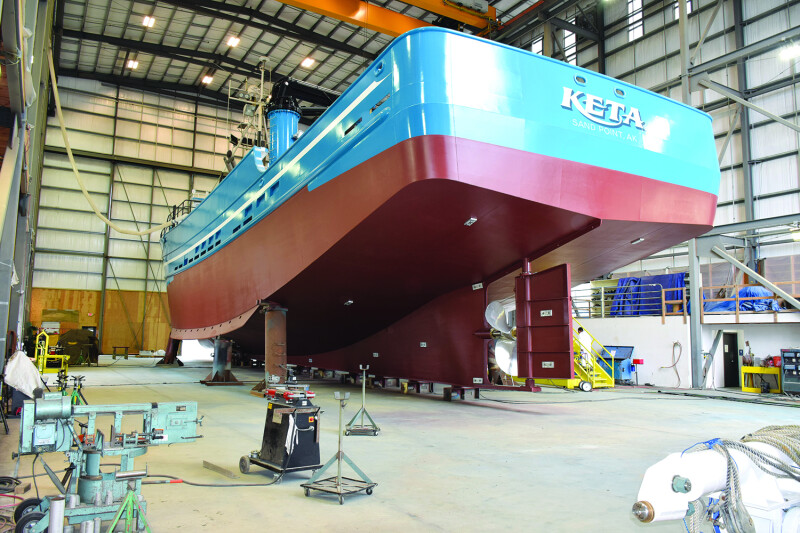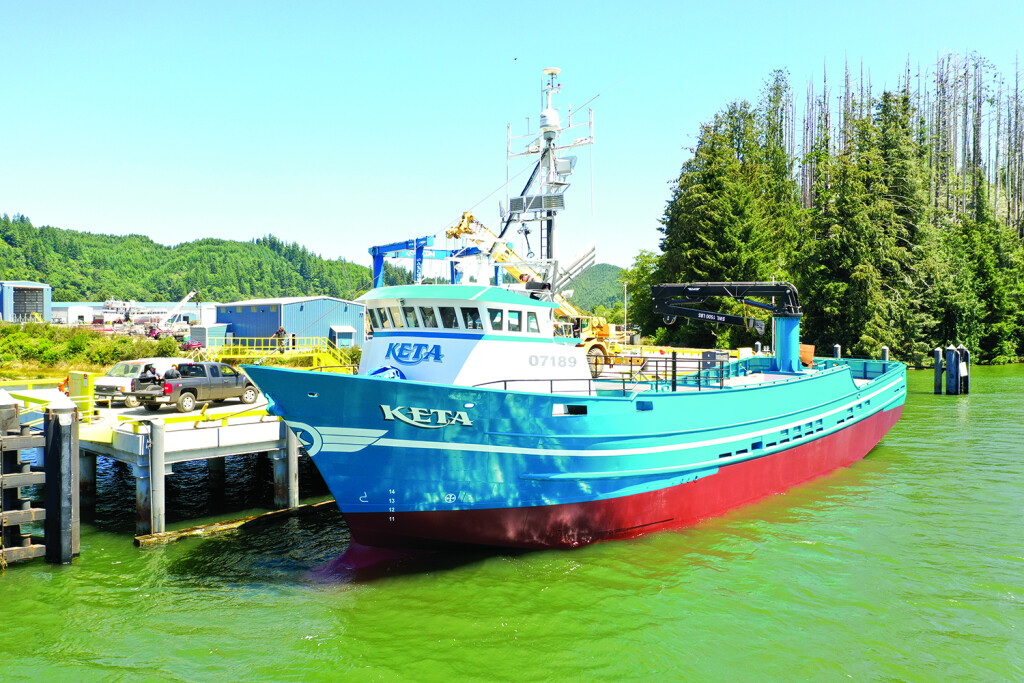The Hansen Boat Co. of Everett, Wash., built the F/V Keta in 1976. Since then, the vessel has made a name for herself, landing king crab from the Bering Sea and Gulf of Alaska. At 83 feet, the Keta was considered a small boat for working in the Bering Sea crab fishery, especially in winter. She is currently at Fred Wahl Marine Construction in Reedsport, Ore., undergoing her second conversion and growing into a 123-foot vessel.
According to Gary Isaksen, a Bristol Bay salmon fisherman and model-boat builder, his father, Bert Isaksen and two partners had the boat built.
“The name Keta comes from the names of the owners’ wives,” says Isaksen. “The K was for Kay Leland, and the E for Elsie Langeseter. The T is for Togetherness, and the A is for Arlene, my mother. It’s unfortunate my father is no longer alive to talk about the boat. He hung on for 93 years. He immigrated from Norway and fished Bristol Bay back when it was still sail.”

Isaksen recalls that his father sold the boat to Buddy Bernstein of Sand Point, Alaska, brother of current owner David Wilson, who has taken on a new partner, Leif Manus, formerly of Trident Seafoods. Both have graciously condoned this story but declined to be interviewed.
Sometime in the 1980s the Keta was reportedly sponsoned and lengthened at Marco Shipyard in Seattle out to 100 feet. A photo posted by Ralph Pelkey on Facebook purports to show her at Akutan, Alaska, in 1984, before she was widened.
Another fisherman familiar with the Keta, Dylan Hatfield, understands that the owners are putting crab quota from other vessels onto the Keta, hence the need to further extend and slightly widen the boat.
“She was laid up somewhere,” Hatfield says. “And as far as I know, they weren’t going to fish her, just as a tender.”
The Keta will still be a tender, and will likely be active again in 2022. The plan was to have the boat ready in April of this year, but covid-19 delays slowed the project.
Nonetheless, the team at Fred Wahl has hammered away at what has been the vessel’s biggest transformation so far.
“We cut off 60 feet and added 83,” says Mike Wahl. “She’ll be 123 feet overall.” According to Wahl, all the design and engineering work was done in-house by the yard’s people.

Wahl’s engineers scanned the Keta’s hull in April 2020, and the vessel arrived at in Reedsport in September that year.
By December, the yard had cut off more than half the vessel and moved the forward section into the one of its large steel buildings for the serious work. With the original engine and generators — a 3508 Cat and a couple of 3306 Cat packages — removed, the yard installed a new main engine and three gensets.
“David [Wilson] has been a good customer of ours,” says Curtis Clausen of Hatton Marine, the company that supplied the engines. “We put an S6R2 into Wilson’s other boat, the Lady Joann. But the Keta is a bigger boat. We put an S12R in her with a Twin Disc MG540 gear with 5.1:1 reduction. They also put in three Bollard MER gensets, two 250-kW 6060 John Deeres, and a 65-kw 4045 John Deere.” According to Clausen, Hatton provides some support to Wahl’s. “We wired up the engine room panel and the helm panel,” he says.
Having the stern off made the re-powering much easier. “It’s the time to do it,” says Mike Wahl. “We’ve done it that way once or twice before, or with the deck off. We had to build up the bed for the main, but the gensets were on skids, so we could slide them in.” The 1,100-hp S12R Mitsubishi is a Tier III engine. “Because it was a repower of a Tier 0, they didn’t need to go to Tier 4,” says Wahl.
With the engines in, Wahl put in an all new Aquamet 22 6-inch-diameter tail shaft and two or three middle shafts and tubing. “We start with a preliminary laser, and then use optical alignment as we start putting on the new stern. It’s pretty intense. We put guides on to keep everything in line as we build.”
Having scanned the vessel, Wahl built up the new stern and hold with pre-engineered steel plate. “It’s all precut from DNC files with our plasma cutter,” says Wahl. “We used all new steel, 3/8" and 5/16".”
The new hold will keep king crab in live tanks and is also equipped with two 50-ton RSW systems for tendering salmon.
“If a vessel needs a 100-ton system or more, we prefer to do two or more smaller systems,” says Kurt Ness of Integrated Marine Systems, which supplied the RSW packages for the Keta. “That way, if one goes down, you don’t lose your season.” According to Ness, IMS works frequently with Wahl, and usually just supplies the components.
“We hang it all and install the compressors and everything,” says Mike Wahl. “Then IMS comes down and does the initial charging of the system.”
Carrying so much water and slush in the hold of a vessel that size might raise some stability concerns. But according to Wahl, tonnage frames and bin boards reduce the movement of the water and the free surface effect that can cause problems.
Crabber Dylan Hatfield confirms that the water is not a problem for most vessels. “We keep the tanks pressed all the time,” he says. “The water flows up over the coaming and down under the false deck, as long as you have scuppers enough to get rid of that water, it’s not an issue.” Hatfield adds that live tanks keep crab remarkably well, even when packing thousands of pounds. “We don’t see more than 2 percent mortality,” he says. “We usually get less than 1 percent.”
The team at Fred Wahl Marine Construction finished off the aft section with a new propeller and rudder, and then moved forward. “We put in a couple of transducer tubes,” says Mike Wahl. “Then we put on a bulbous bow and made the ice belt thicker. We did some repair work on the crew quarters. She has room for about six crew members.”
Wahl’s team did not do anything new with the electronics. According to Steve Wallace at Lunde Marine Electronics, the last time the Keta got a big electronics package was when the wheelhouse was replaced in 1994.
“She got a couple of Furuno radars, a sounder, a gyro, an autopilot and a couple of sidebands,” says Wallace. “All we did this year was sell them a new computer. It’s a navigation computer they use with ECC-Globe. That’s a chart system all the boats use up in the Bering Sea.”
With the Keta painted her traditional blue, Wahl launched the boat in July 2021 with sea trials scheduled for August. “We did the preliminary stability work,” he says. “But the final stability report will be done after sea trials.”
Because of pandemic-related delays, Keta missed tendering this year’s sockeye season in Bristol Bay. But for a vessel that has already put 45 years of fishing under her keel, a new hull and repower should bring many more to come.







